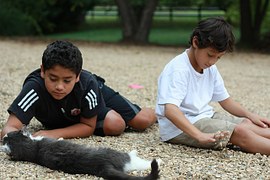
Whilst it is good to encourage a relaxed attitude to dogs, it’s not a good idea to let your child run up to strange dogs as their exuberant petting may not always be appreciated. Children are often drawn to little dogs and some breeds, such as Jack Russells, can bite or be quite grumpy with strangers.
You will need to keep your child away from your pet’s faeces, whether in the litter tray or out in the garden. There are rare cases of children being blinded by toxocariasis which is caused by roundworm parasites (Toxocara) found in cat, dog, and even fox faeces. It’s important to keep your pets regularly wormed and make sure your child learns how to wash their hands in warm soapy water before meals and snacks.

I am always staggered by quite how much my children love our cats and dogs that live on our street. They adore them and display such kindness and warmth around them. They really do see them as part of the family and develop complex relationships with them involving lots and lots of conversations and petting.
A trustworthy pet can be a wonderful companion to a child whether it’s a cat that loves to be stroked, or a dog that matches your child for boundless energy on a walk – the bond can be very strong.
Cats, dogs, guinea pigs (and even chickens) are very good for practicing social skills although it makes me laugh how children love to order pets around. They enjoy the feeling of power and luckily dogs will accept their instructions and cats will just ignore them.
Pets have been shown to have a powerful preventative effect on a toddlers and children developing allergies. A study supported by the American National Institute of Allergy and Infectious Diseases reported that toddlers exposed to two or more dogs or cats during the first 12 months of life were on average 66-77% less likely to have any allergic antibodies to common allergens compared with toddlers exposed to only one or no pets in the first 12 months. This wasn’t just a reduction in so-called pet allergies but a reduction in a whole raft of allergies that plague modern children. Subsequent studies have backed up this finding.
Furthermore, scientists in Finland reported that babies who spent up to 6 hours a day at home with a family dog had fewer ear infections, upper respiratory tract infections and less need for antibiotics than babies who had no pets at home.
A study from the Research Center for Human-Animal Interaction at the University of Missouri has reported that pets can increase the social skills of children with a variety of development disabilities. Furthermore, pets are a great development aid for autistic children.
Gretchen Carlisle, one of the authors of the study, explained that autistic children who lived with a pet or pets were significantly more likely to behave in social ways including:
She put the increase in these skills down to a general increase in their assertiveness.
The pet didn’t have to be a dog and Gretchen made the astute point that autistic children were highly individual and a dog might not be appropriate for all autistic children. So – see how your child reacts to a variety of animals before taking the plunge and getting a pet. You can do this by asking friends with cats, dogs, guinea pigs etc. to let you and your child visit and spend time with their pet. If you cannot get your own pet, you can look at sponsoring a pet e.g., a donkey which gives your special needs child opportunities to visit, pet and groom their sponsored animal.
NIH/National Institute Of Allergy And Infectious Diseases. “Multiple Pets May Decrease Children’s Allergy Risk.” ScienceDaily. ScienceDaily, 28 August 2002.
Bergroth et al (2012) ‘Respiratory Tract Illnesses During the First Year of Life: Effect of Dog and Cat Contacts’ Pediatrics 2(1): 211 -220 (doi: 10.1542/peds.2011-2825)
Carlisle (2014) ‘The Social Skills and Attachment to Dogs of Children with Autism Spectrum Disorder’ Journal of Autism and Developmental Disorders 45: 1135- 1145
Dog Bite-Related Fatalities — United States, 1995-1996, MMWR 46(21):463-467, 1997.)